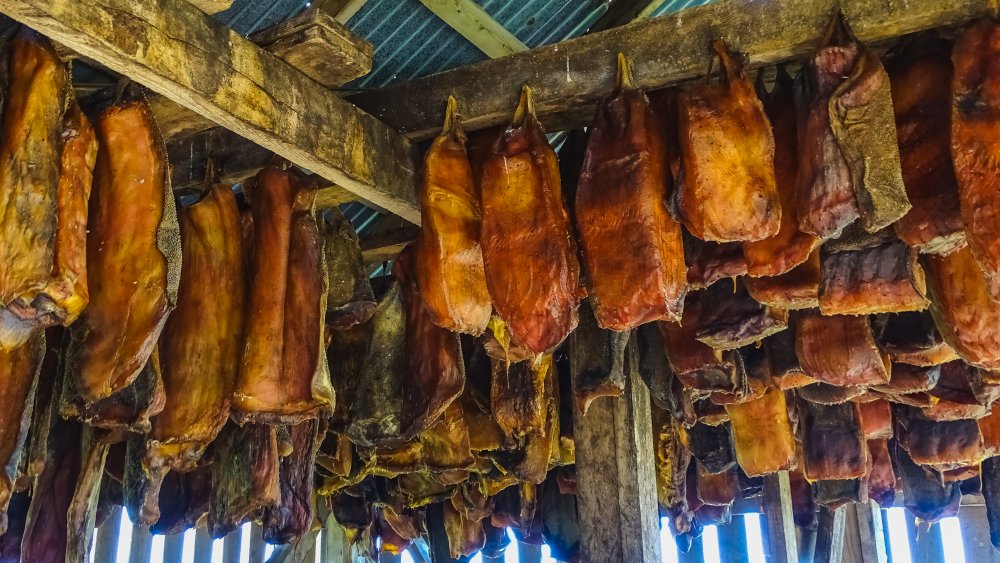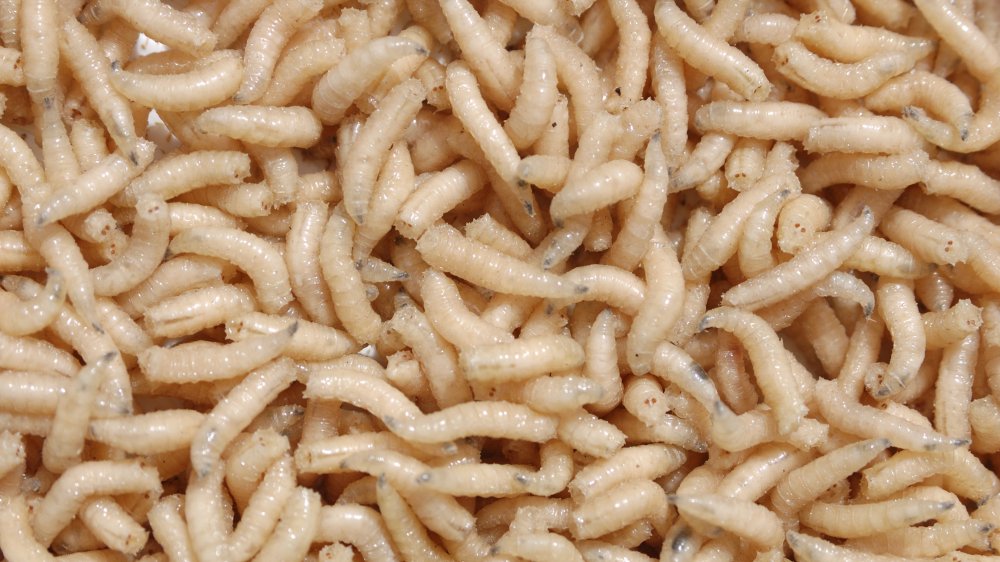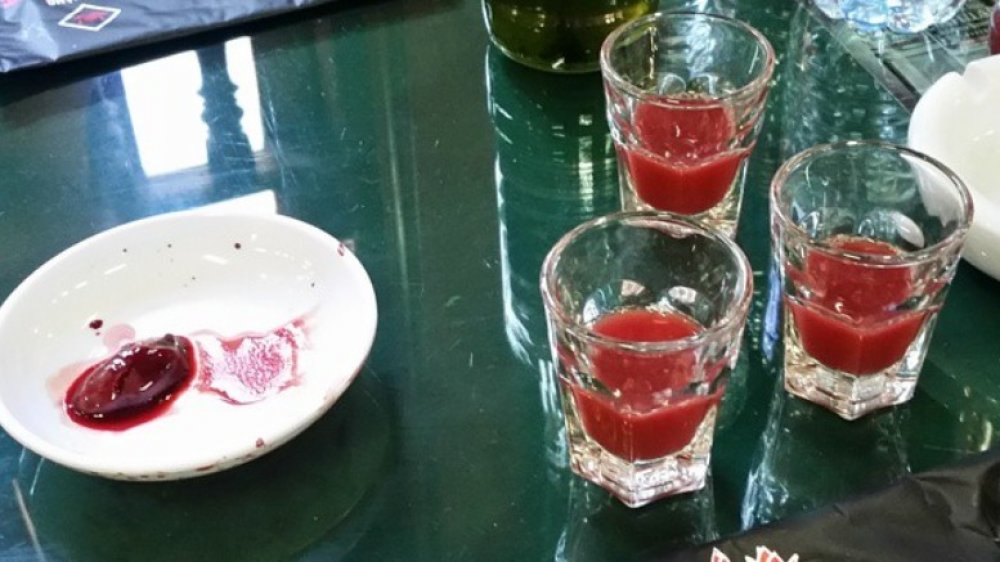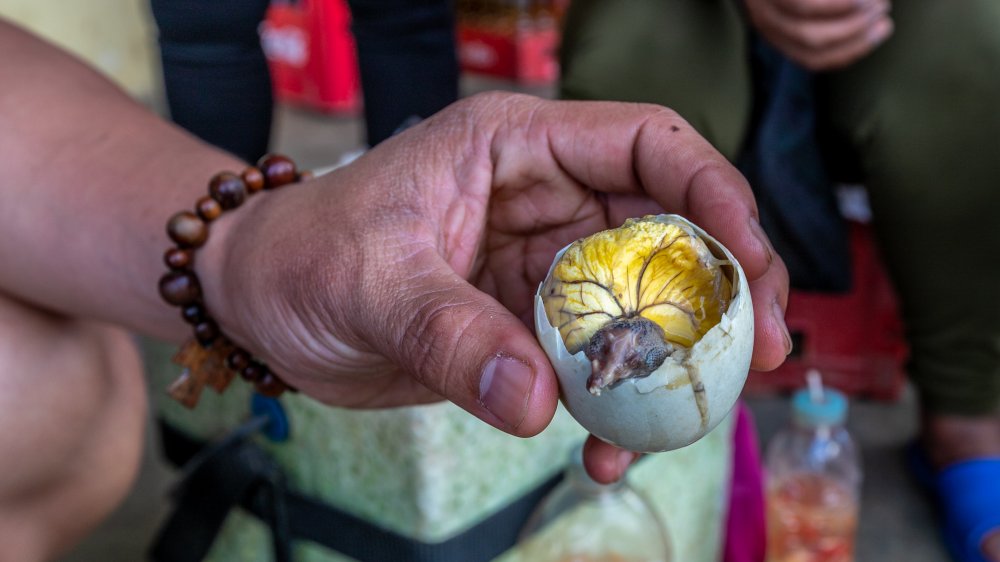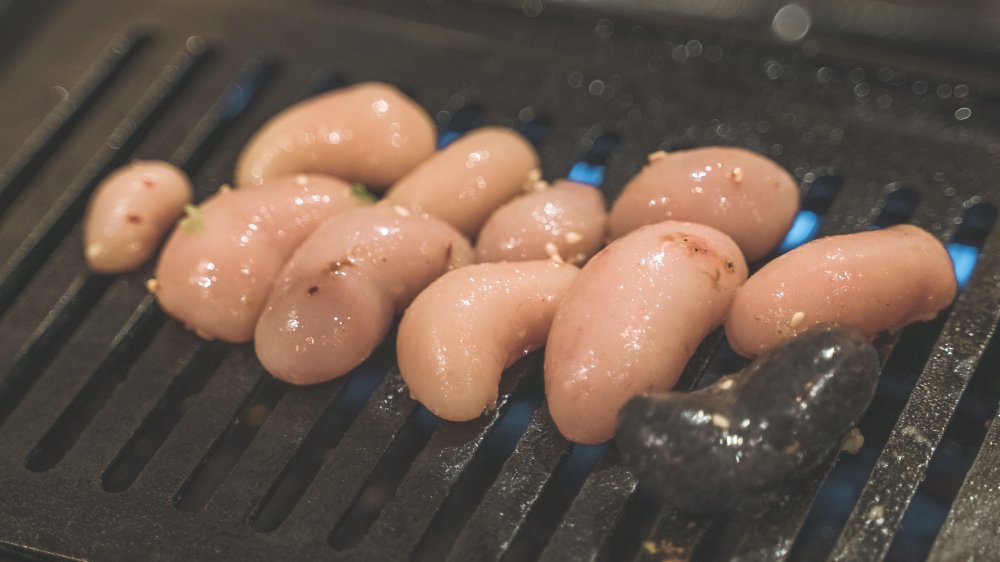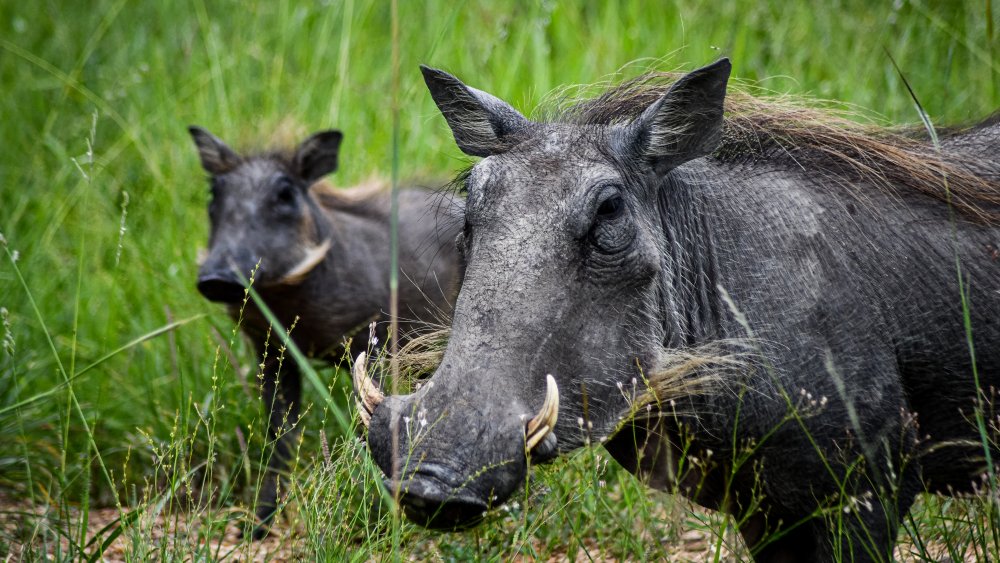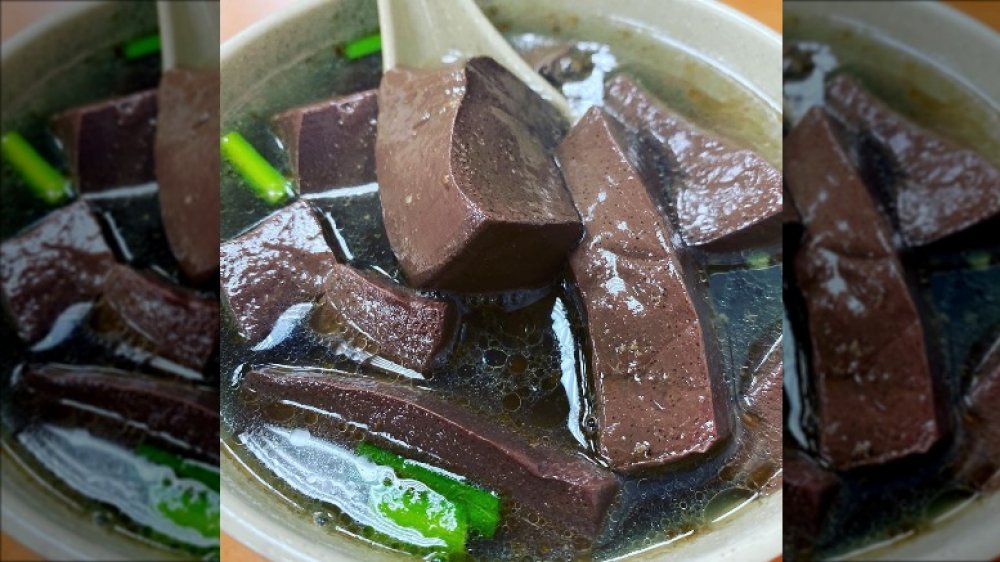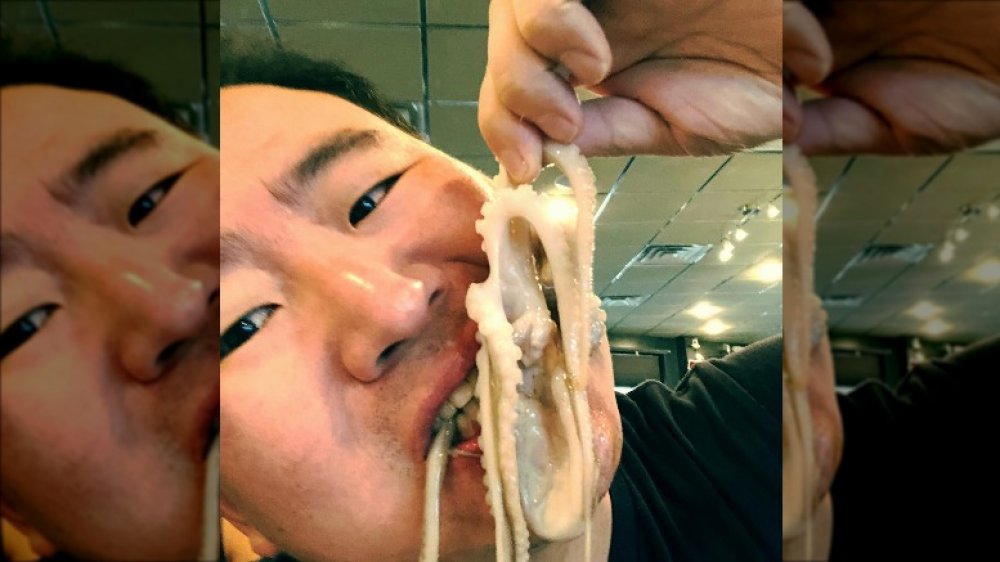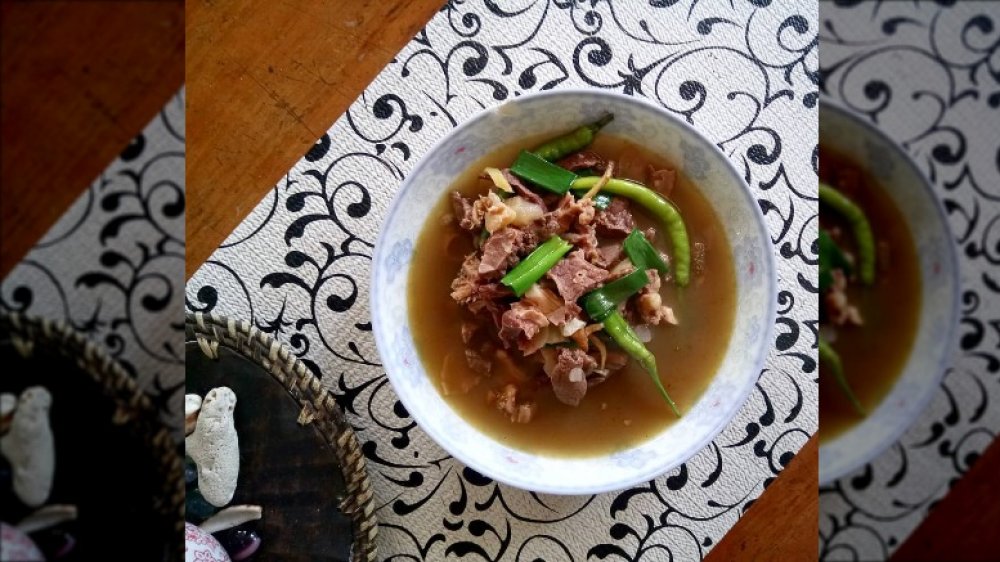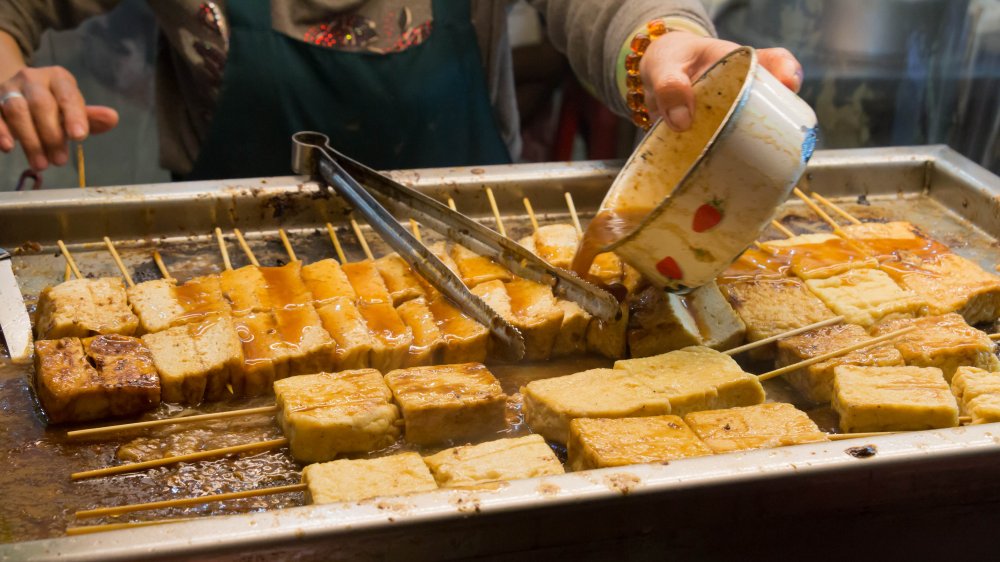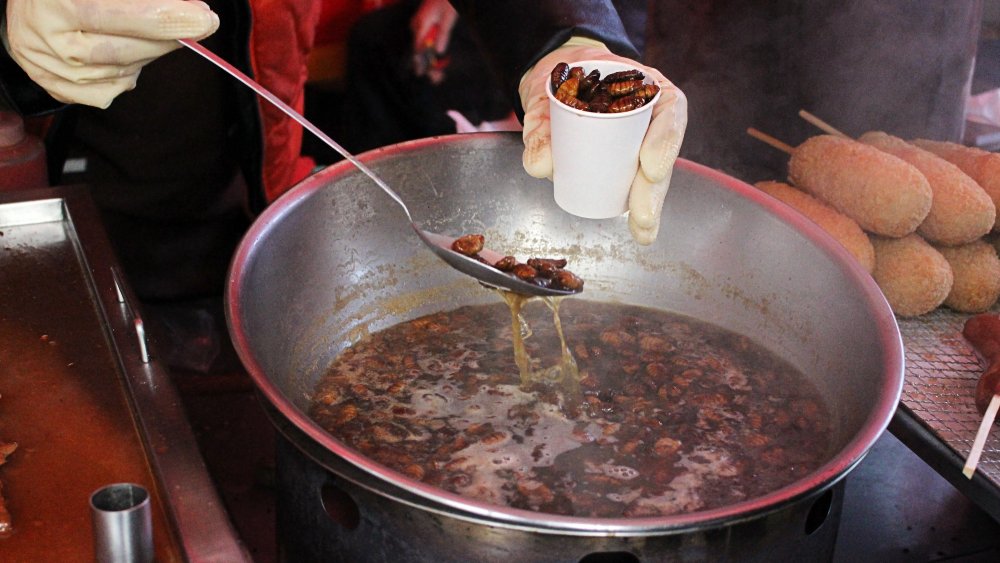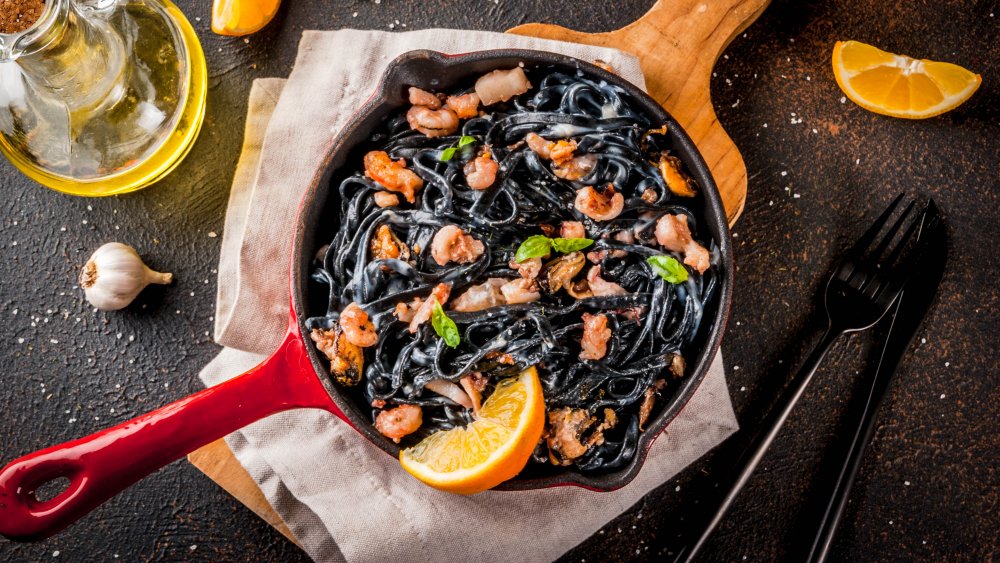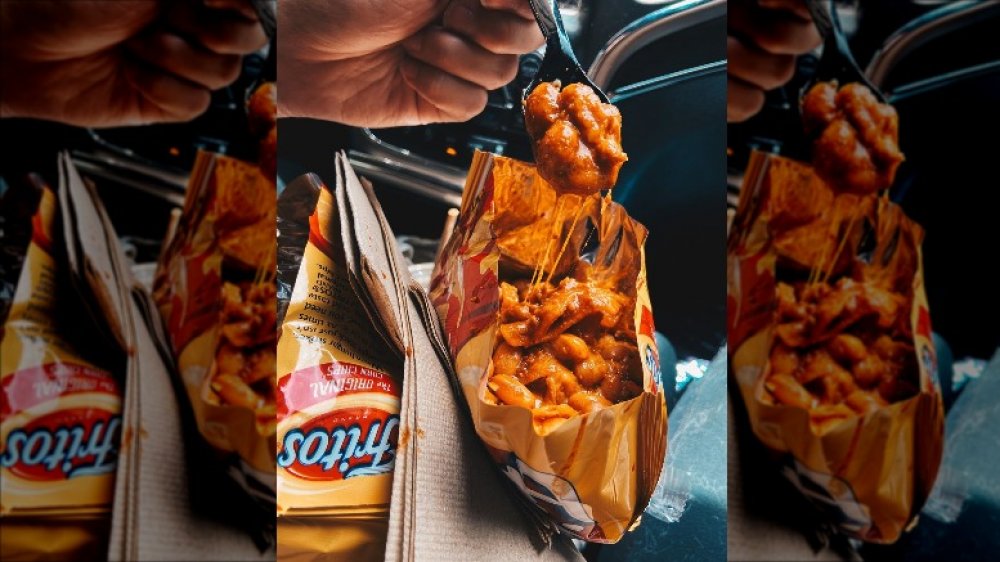The Craziest Things Anthony Bourdain Ever Ate
Anthony Bourdain was one of the most beloved and well-known food journalists of our time. Chances are, you've seen at least one of his shows, like A Cook's Tour, No Reservations, or Parts Unknown. He was also a chef and an author, and he is largely responsible for popularizing the so-called "foodie" culture. He introduced countless viewers to new and interesting dishes they may never have otherwise even heard of (we probably wouldn't have tried uni without him, to be fair).
While a lot of the dishes Bourdain ate on his shows looked absolutely amazing (like the mouthwatering francesinha he ate in Porto, Portugal), some of the stuff he tried seems a little more questionable. Don't get us wrong — we love to try new and unusual foods — but everyone has a limit to what they'll try. Maybe Bourdain was just a bit braver than a lot of folks when it came to the food on his plate. If you want to get a taste of what it must have been like to eat with Anthony, let's take a look at some of the craziest things that Anthony Bourdain ever ate.
Fermented shark
Perhaps one of the most widely cited strange foods to pass Bourdain's lips was hákarl, or fermented shark, which he tried in a 2004 episode of No Reservations. More specifically, it's essentially rotten and dried, and it's actually considered an Icelandic delicacy.
Despite its celebrated status in Iceland, though, it's known for having a particularly... strong, let's call it ... taste. Sounds like something that most people would avoid, but maybe you're wondering if Bourdain liked it. Well, not exactly. He actually called it "the single worst, most disgusting, and terrible-tasting thing." Ouch.
And he's not the only one who couldn't manage to stomach it. Apparently, Gordon Ramsay couldn't even swallow it. What many people who try this "treat" first notice is the smell. It's incredibly strong, and it comes from ammonia, which sharks will excrete from their skin (though you may have heard of it because it's also in urine).
Apparently, the taste isn't much better. Because, what else would you expect from a cured, rotting fish? We'd all love to try even a quarter of what Bourdain had the chance to eat in his time, but we're probably lucky we didn't have to choke this stuff down for the sake of being polite.
Maggot fried rice
Fried rice: Who doesn't love it? Even if you're not a huge fan of Asian food, it's hard not to enjoy well-cooked fried rice, especially if it has a nice crispiness to it. While basic fried rice is always nice, this versatile dish gets even more special when you add your favorite ingredients. For most people, those ingredients might include veggies like carrots and onions or protein like chicken or even pork. But one ingredient you probably haven't thought about adding to your fried rice is maggots.
Why would anybody put maggots in fried rice, you ask? Great question. Bourdain got to try it out for himself, though. According to The Daily Meal, he ate this dish on an episode of CNN's Piers Morgan Live in which he was trying a variety of shall we say "adventurous" foods. Right after he took a bite, he had to take a sip of wine to wash it all down. When he was offered a second bite, he turned it down. We can't blame him for that.
Cobra heart
Bourdain has expressed his love for Vietnam many times. In fact, he once said that the country was "one of his favorite places on earth." It's easy to see why — Vietnam has a vibrant food culture with a myriad of influences that give many of its dishes flavor profiles you won't find anywhere else in the world. The popularity of Vietnamese food has arrived in the West in the form of pho, but the country's cuisine goes much deeper than a simple bowl of soup.
There's a lot of exploring to do when it comes to Vietnamese dishes, but one item you probably don't want to start with is a cobra heart. Bourdain has eaten his fair share of internal organs, but this experience was even more extreme. Cobra hearts aren't just eaten for their nutritional value or their taste — they're also believed to have a positive effect on male virility. Shockingly, the heart is often put into the bowl while it's still beating. The adventurous soul who chooses to consume it then takes it all on one shot, much like an oyster.
Bourdain claimed that he could actually feel the heart pulsing as it went down — which is probably enough to turn you off of this dish if you haven't already gotten queasy and skipped to the next section.
Balut
Here's one that might not sound too appetizing but that Bourdain didn't seem to mind too much: fetal duck egg. It's also known as balut, and it's traditionally eaten in the Philippines. Bourdain scarfed this street food specialty down on a live Piers Morgan program, according to The Travel, and he said the taste wasn't offensive.
The only thing that turned him off? The texture. Apparently, there was a crunchiness to the egg, which could likely be from the duck parts he was voluntarily ingesting. It's also known as an aphrodisiac (because of course), so the next time you're having a romantic night with your partner, you may just want to pass on the oysters and the chocolate and share a fetal duck egg instead. There's no better way to get in the mood.
In all seriousness, this dish is likely less intimidating than it seems. Just because it's not something we see all the time in the U.S. doesn't mean it's not something you should try on your next trip to the Philippines.
Raw eyeball of a seal
Eating seal meat may not sound particularly appetizing to you if you've never had it before. But for the Inuit people, seal is an essential part of a healthy diet. A seal is just a mammal, after all, so how bad could it really be? They have plenty of blubber, which means you're likely to get some of that fatty richness on your plate if you ever decide to try it out.
Bourdain got the chance to eat seal on a trip to visit the Inuits of Quebec, Canada, when he was filming No Reservations. Because he was trying something new, his guests wanted to give him the whole experience. Therefore, they gave him a little piece of everything. He got to try the kidney, the liver, and perhaps most surprisingly, the eye.
You might think that a seal eyeball would be hard to eat and maybe less than appetizing. But Bourdain simply described it as "not bad." Maybe we should all give it a try.
Various kinds of testicles
To most people living in the Western world, the concept of eating testicles sounds patently unappetizing. But in many other parts of the world, it's considered wasteful if you don't eat all the meat any given animal provides. Throughout various countries around the world, eating testicles is seen as commonplace and even delicious. Some cultures even believe it gives you a "boost," whether sexually or in general, according to Vice.
And Bourdain has certainly had his fair share of testicle dishes in his time. He got the opportunity to try bull testicles in Nicaragua, and he saved the sheep's testicles for the heat of the Moroccan desert. Of course, you can't forget the turkey testicles he ate on Piers Morgan Live.
If he tried so many different iterations of this particular body part, he must not have minded it too much. And it makes sense. When you think about eating testicles, it might sound gross. But at the end of the day, it's just a piece of meat. Once you can get over the mental block, it's probably something that most of us with adventurous spirits wouldn't mind trying.
Warthog anus
A Cook's Tour is one of Anthony Bourdain's lesser-known series, but it provided him the opportunity to set himself apart from other television foodie personalities by trying some interesting foods that most of us have never heard of. One of his stranger taste tests on this show? Warthog anus.
If you've seen much of Bourdain's programming before, you know he's always encouraging his viewers to have an open mind. After all, food is just food, and until you try something (even something you might consider really "exotic"), you really have no idea if you truly like it. But when it came time to eat warthog anus, this is what Bourdain had to say: "All those years of telling you to eat as the locals do, take a chance, don't be squeamish, they're all coming back to haunt me. Behold the worst meal of my life."
These are strong words from someone who literally made his living eating unusual foods. Perhaps it was so unpleasant because the rear end of this animal was completely unwashed: filled with dust, dirt, and yes, even fecal matter. Bourdain still wanted to show respect, even though he knew he was probably going to get sick. He said, "The chief is there in front of his whole tribe offering you his very best. Show respect. I'm lucky to be there. I'm lucky to see that. I'm lucky to have that experience. Chewing some antibiotics is a small price to pay."
Pig blood soup
Thailand is now a top travel destination for many people in the Western world who want to experience the stunning scenery, culture, and, perhaps most importantly, the absolutely mouthwatering food there. But the Thai food you're used to eating in the States is likely a watered-down version of the real thing.
Bourdain wasn't afraid to try one of the most unusual items on a menu at a restaurant famed for using every part of the animals it cooked. Enter the pig blood soup. In Thailand, it's known as luu, but don't assume that it's wildly popular across the whole country. It's mostly eaten in Northern Thailand, and it's apparently pretty niche.
While Bourdain said he was hesitant to eat this soup because it looked so bloody, he admitted that it had a nice flavor once he'd tried it. A little sweet, a little spicy. What's not to love about that?
Live octopus
This is one dish that takes some bravery to eat. Not because of the taste, per se, but because of the fact that it's actually still alive — and can seriously harm you. Live octopus is considered a delicacy in some parts of Japan and South Korea. And when we say live, we mean live. As in, it's actually moving, and you might just have to chase it down. It's also a choking hazard, because, in a last-ditch attempt to escape your stomach acids, there's a chance the octopus could stick to your throat.
That didn't stop Bourdain from trying it out, though. Surprisingly, he tried this dish in New York City at a spot called Sik Gaek, not in Japan or Korea. If you want to follow in Bourdain's footsteps, you're not just going to need the courage ... you'll also need the money. Seeing as it's a delicacy, it doesn't tend to come cheap. Are you ready to fork over the big bucks for this somewhat-scary experience?
Stomach bile soup
When Anthony Bourdain traveled to the Philippines, he was convinced to try something that he wasn't too excited about: stomach bile soup. He'd tried it before and hadn't been a fan, so he wasn't exactly eager to relive the experience. To be fair, it doesn't sound great. The soup is basically just chunks of meat cooked in a broth largely made of stomach bile. This specialty is known as pinapaitan, and the name is derived from the word "pait," which literally means "bitter." It's also known for being quite spicy.
Luckily, Bourdain was happily surprised. Despite his lack of enthusiasm at first, it turns out he quite enjoyed the soup. It's certainly not the first time he thoroughly enjoyed something he didn't initially think he would like. But for true Bourdain fans, it shouldn't come as too much of a shock that he liked this meaty soup: He did call himself a "committed carnivore," after all.
Stinky tofu
You may think that you love Chinese food, but if you've never actually tried some in China, you may be mistaken. The foods people in the U.S. think of as Chinese food are often not that Chinese at all. In fact, it's often difficult for Westerners to enjoy many of the typical flavors and textures you'll find in authentic Chinese cuisine right off the bat.
That's why it's not too surprising that Bourdain had a difficult time choking down the stinky tofu he managed to try when he was in China. This stuff is known for being served as street food, and that makes sense once you get a whiff of the super-strong smell — this isn't exactly the kind of dish you want to be making in a poorly ventilated apartment.
Bourdain wasn't a huge fan, but he may not have hated it as much as Andrew Zimmern did when he tried it out for himself. He had a hard time choking it down, too.
Beondegi soup
Anthony Bourdain took a trip to South Korea when he was filming Parts Unknown, and it was there that he had the opportunity to try Beondegi soup. If the thought of eating bugs freaks you out, you may want to avoid this one completely. That's because the main ingredient in Beondegi soup is silkworm pupae, otherwise known as larvae. Not only is the idea of this soup unusual to many of food fans in the West, but the smell is also quite strong, giving it quite a distinct flavor.
Bourdain is a more adventurous eater than most, as you apparently won't find many tourists who want to order it. Even if you can get over the smell, you still have to mentally steel yourself to get over the fact that you are, in fact, eating bugs. If you want to try it, though, just take a trip to Seoul and visit some street vendors — you're sure to find it there.
Cuttlefish ink
Many of the interesting foods Bourdain has eaten have come from Asia, but the cuttlefish ink he tried is thoroughly rooted in the West. This Italian favorite may sound strange, but the flavor isn't too intense or overpowering. Spaghetti al nero di seppie hails from both Sicily and a northern region of the country known as Veneto. The ink is added to the pasta to produce a black-colored noodle. Sometimes, it's served with squid or shrimp along with veggies, olive oil, and garnishes.
Most tourists visiting Italy stick to the classics they already know and love, but if you're looking to try something new, you shouldn't be afraid to order it. While the appearance may throw you off at first, it actually tastes quite good. The ink adds a slight seafood-y flavor, so if you already love dishes like calamari, you'll probably like this pasta too. One thing is for sure: Anthony Bourdain has certainly eaten stranger foods in the past.
Frito pie
While Bourdain may not have been a huge fan of this item, we have to admit, it doesn't sound too bad. The Frito pie: If you know, you know. Bourdain wandered upon this — delicacy? abomination? — in New Mexico when he walked into a tourist shop, and he knew he had to try it.
This strange-sounding menu item is often served inside a ripped-open Frito bag, and inside you'll find an unholy mixture of cheddar cheese, canned chili (though it can also be made with fresh ingredients), and, of course, Fritos. All of this together comes together in a soup-like mixture that may not have the best texture but certainly packs a lot of flavor. The best versions of this dish have some veggies on top for some added crunch and freshness, which — let's be honest — this dish certainly needs.
It may not be the most stomach-turning concoction the TV personality has ever eaten, but he still said his consumption of the Frito pie offered him "a level of self-loathing" comparable to a night of drinking too much. (But he still finished the bag. Can't blame him.)

